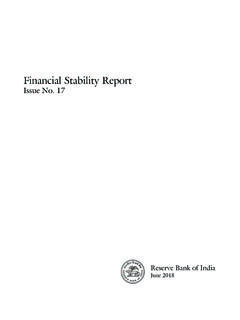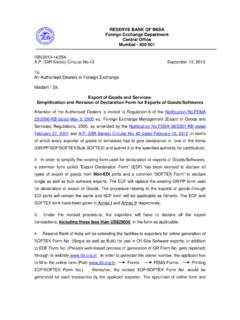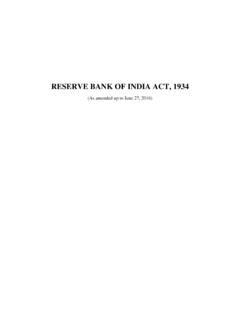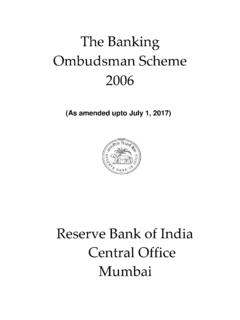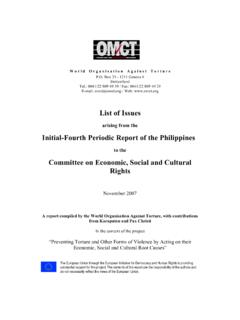Transcription of Green Finance in India: Progress and Challenges*
1 ARTICLERBI Bulletin January 202161 Green Finance in india : Progress and Challengesfunds) are being established. They together constitute Green finance1. Green Finance is central to the overall discussion on sustainability of economic growth. Rapid economic development is often achieved at the cost of environment. Dwindling natural resources, degraded environment and rampant pollution are hazardous to public health and pose challenges to the sustainable economic growth. In order to protect and substantially improve the environment, nations around the world have been increasingly focusing on the use of eco-friendly technologies. However, it requires appropriate incentive structure for increased allocation of funds towards setting up or adopting environmentally sustainable projects. Once funds are freed from the conventional industries and are channeled into the Green and environment- friendly sectors, other resources including land and labour may also follow.
2 This eventually leads to an optimal allocation of resources2 that support sustainable growth in the long run. In order to achieve these objectives, targeted policies on Green Finance have been formed in major countries involving all stakeholders of economic growth, viz., corporates, governments and central banks. In this article, we assess the Progress of Green Finance in india . In Section II, we briefly discuss some of the best practices followed across the globe for promoting Green Finance and some of the major initiatives taken in india . In Section III, we outline the Progress of Green Finance in india . In Section IV, we discuss the challenges and way forward and Section V Public policy towards Green Finance (a) International best practices Climate change has been on the G20 agenda ever since its first summit in 2008, though more recently Green Finance is fast emerging as a priority for public policy .
3 This paper reviews the developments in Green Finance globally and in india . We use a variety of data sources to assess both the extent of public awareness (Google Trends) and financing options (bank credit and bond issuances) for Green projects. Our findings indicate that while there have been improvements in public awareness and financing options in india , a reduction in asymmetric information through better information management systems and increased coordination amongst stakeholders could pave the way towards a greener and sustainable long term economic Green Finance refers to the financial arrangements that are specific to the use for projects that are environmentally sustainable or projects that adopt the aspects of climate change. Environmentally sustainable projects include the production of energy from renewable sources like solar, wind, biogas, etc.
4 ; clean transportation that involves lower greenhouse gas emission; energy efficient projects like Green building; waste management that includes recycling, efficient disposal and conversion to energy, etc. Moreover, project defined sustainable under the disclosure requirement for Green Debt Securities include climate change adaptation, sustainable waste and water managements, sustainable land use including sustainable forestry and agriculture, and biodiversity conservation (SEBI 2017). In order to meet the financial needs for these types of projects, new financial instruments such as Green bonds; carbon market instruments ( carbon tax); and new financial institutions ( Green banks and Green * This article is prepared by Saurabh Ghosh, Siddhartha Nath and Abhishek Ranjan of the Strategic Research Unit of Department of Economic and policy Research (DEPR).)
5 The views expressed in this article are those of the authors and do not necessarily represent the views of the Bank. Support extended by the research interns are Finance in india : Progress and Challenges* 1 (Asian Development Bank)2 Establishing China s Green Financial System, Report of the Green Finance Task Force, April Bulletin January 202162 Green Finance in india : Progress and Challengesthe focus has been on circular carbon economy (CCE) to deal with harmful emissions. There are several flagship programmes that aim at increasing the awareness and promoting the funding of Green initiatives across the globe. These programmes encourage financial and non-financial firms to embed environmental considerations into their financing. Major flagship programmes like Principles for Responsible Investment (PRI), Equator Principles (EP) for financial institutions, United Nation s Environment Programme (UNEP) and Statement of Commitment by financial institutions on sustainable development suggest ways for implementing Green Finance among the signatories.
6 Several entities from india are signatory to these programmes (Table 1). However, it is possible to ensure a steady flow of Finance into sustainable projects only if there is any reliable source of information on the entities overall management of environmental and social risks, track record on entities identification of opportunities that bring both a decent rate of return and environmental benefits (UNEP)3. In this regard, Sustainable Stock Exchange is an initiative that recommends the signatory countries stock exchanges to come up with stock price indices that track the stock performance of a set of companies operating in these countries, which are leaders in recognising the Environmental, social and Governance (ESG) principles4 into their financing aspects . These indices are aimed at guiding investors who are interested in investing in Green activities.
7 Two major stock exchanges in india , the Bombay Stock Exchange (BSE) and the National Stock Exchange (NSE) are part of this initiative and publish separate ESG indices. The regulatory framework across the globe can be broadly categorised into four. First is the sustainability disclosure by financial and non-financial companies, by which the companies are asked to periodically report their exposure to the ESG related risks from their operations. Such disclosures have picked up following the thrust given by G20 by encouraging a voluntary adoption by corporates of the recommendations of the Task Force on Climate-related Financial Disclosures (TCFD). As of June 2020, 60 per cent of the world s 100 largest public companies committed supporting the TCFD recommendation5. The leading stock exchanges, financial market regulators and the ministries dealing with the corporate affairs in China (2008)6, Hong Kong (2012), UK (2012), india (2012), the Philippines (2013), Vietnam (2013), Singapore (2016) were among the nations to implement the framework for disclosure of ESG-related risks by the listed companies in their jurisdiction (Volz, 2018)7.
8 Bangladesh mandated bi-Table 1: Participation of Asian Financial Institutions in Global InitiativesName of the initiativeGlobal signa-toriesAsian Signa-toriesGlobal signa-toriesAsian Signa-toriesFrom Volz, 2018As at end 2019 Principles for Responsible Investment1,8741222,698387 *Equator Principles Financial Institutions911210122 **UNEP Statement of Commitment by Financial Institutions on Sustainable Development (2011)21438 Sustainable Stock Exchanges6614 **Source: Volz, U. (2018, March). The latest information collected from the programmes : Asia includes Australia and New Zealand.*: Includes 3 from india : SBI Funds Management Private Limited, Equicap Asia Management Private Limited and Indus Environmental Services Pvt. Ltd.**: Only IDFC from india .**: Includes both Bombay Stock Exchange (BSE) and National Stock Exchange (NSE) from See Environmental, social and governance (ESG) principles are a set of standards for a company s operations that are compliant with certain social , environmental and governance standards.
9 It is a benchmark that many investors use to assess sustainability of their potential investments. Environmental criteria consider how a company balances its operation with environmental costs. social criteria deal with companies relationships with their employees, suppliers, customers, and the communities where it operates. Governance deals with a company s leadership, executive pay, audits, internal controls, and shareholder Third TCFD Status Report Shows Progress & Highlights Need for Greater Climate-Related Disclosures and Transparency6 Stock exchange in Shanghai. 7 Parentheses indicate the years of adoption of the sustainability disclosure by these stock Bulletin January 202163 Green Finance in india : Progress and Challengesannual reporting of corporate social Responsibilities (CSR) undertaken by the commercial banks in 2008, incentivised systematic environmental risk analysis as part of the credit appraisal by the banks in 2011 with the extension of the norm to Non-Banking Financial Institutions (NBFIs) in 2013 and further included assessment of social risks in 2017 (Volz, 2018).
10 Bangladesh released a uniform risk reporting format for the banks as early as 2013. The Energy Transition for Green Growth Law passed by France in 2015 mandated the asset owners and managers to report on how physical and transition risks impact their activities and assets. This policy aims to link disclosures to the broader efforts to decarbonise the energy sector in France8. Second is the directed and concessional lending, that is practised in several countries. For example, a revolving fund of US$26mn was set up under the Green re-financing scheme in Bangladesh in 2009 to disburse low interest loans to over 50 renewable energy and Green industries. Further, an additional fund of US$200mn was set up for the leather-textile industry for switching to Green technology in 2016.
